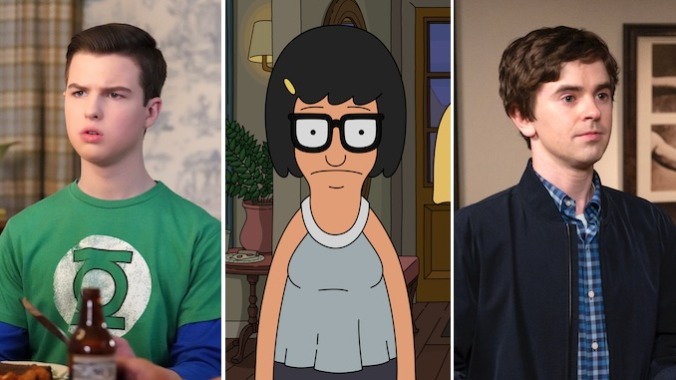Neurodiversity on TV: What’s Healthy, What’s Harmful, and What Gives?
Photos Courtesy of CBS, FOX, and ABC
I liken onscreen neurodiverse representation to a first impression. The social stakes are high, and once a feeling or opinion attaches itself to this initial interaction, rewriting it is tricky. For many, a “normal-adjacent” TV or movie character is their introduction to the beautifully offbeat people for whom society isn’t built, a crash course in lived-in differences and how those shape an individual’s navigation of the world. Television, with its capacity for establishing and sustaining character arcs across multiple years and seasons, remains an apt venue for exploring this topic. Why, then, does Hollywood repeatedly bungle its portrayals of the chronically underestimated and clinically dismissed?
Neurodiversity—the nifty catch-all for autism, ADD, ADHD, bipolar, dyspraxia, and other neurological conditions—isn’t a tough concept to wrangle. The term advocates for the framing of brain development as a “one size fits one” phenomenon. It isn’t one set of characteristics, nor is it a conclusion you can glean from one or two interactions with most neurodivergent people. It’s a confluence of differences and deviations that society consistently interprets as defects.
As an autistic man and avid consumer of pop culture, I’m well-acquainted with the TV industry’s efforts to do right by people like me. For years, though, I didn’t know what quality representation looked like. I couldn’t explain why The Big Bang Theory‘s handling of Sheldon Cooper made me feel like I was being misrepresented, nor could I make sense of the nagging discomfort I felt when that cheerleader in Glee used her Asperger’s diagnosis to avoid accountability. Hollywood was merely amplifying pain I already felt, echoing trauma-backed internal yammering that soundtracked my every day, but I hadn’t tuned into that yet. I was so hungry for onscreen validation that my bar for autism portrayals started and stopped at “If it exists, it’s welcome.”
The relative nebulousness of these conditions means their reflections get to be complex. Hollywood’s impulse to filter every moment through an “auprism” (holla to fans of clumsy portmanteaus!), a neurotypical perspective on neurodiverse experiences, foments an otherness that impacts us daily. We’re so much more than our faux pas, goldfish-y attention spans, and sensory sensitivities. But even earnest portrayals, such as The Good Doctor‘s autistic surgeon Shaun Murphy, still don’t overcome a nonsensical need to fix every moment to a “Don’t forget the autism!” axis. It’s why we get season after season of a specific character or dynamic without ever coming to know them outside of their neurodivergent traits. Yes, autism affects every area of a person’s life. But we aren’t lists of boxes to check. Luckily, a template for better representation exists: Tina and Gene Belcher, the fan-labeled autist and ADHDist, respectively, from the animated sitcom Bob’s Burgers. (More on them shortly.)
I’ve found that assessing neurodiverse depictions boils down to: does this portrayal ever coalesce into a person? What about a likable person? Likability matters here because we already fight so many misconceptions about our temperaments, preferences, limitations, and intentions. It’s why I bristle at the very concept of Sheldon Cooper. Poor writing and preconceived notions overcome Jim Parsons’ genuine attempt to do right by Sheldon. His characterization amounts to a sloppy-toppy ouroboros, a smug poster child for the uppity subgroup of autists sometimes called “aspholes.” However, as wild as this sounds after that statement, I don’t think series creator Chuck Lorre intends any harm. He has stated that he didn’t write Sheldon as autistic, and that committing to a label could harm people who actually have to deal with the condition.
But The Big Bang Theory spinoff Young Sheldon, airing its series finale this week, doubles down on its lead’s harmful traits, even as it takes frequent stabs at a compassionate portrayal. It makes a point to show us the 10-year-old genius separating his peas from his carrots on his dinner plate. The Season 3 premiere “Quirky Eggheads and Texas Snow Globes” opens with Sheldon’s mother walking in on her son experimenting with sensory deprivation techniques. The entire show consists of moments like these, moments that spell out, in flickering neon: are you sure [he isn’t autistic]?
-

-

-

-

-

-

-

-

-

-

-

-

-

-

-

-

-

-

-

-

-

-

-

-

-

-

-

-

-

-

-

-

-

-

-

-

-

-

-

-








































